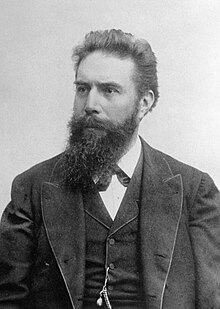Wilhelm Röntgen
Wilhelm Conrad Röntgen (27 Mairch 1845 – 10 Februar 1923) wis a German pheesicist, who, on 8 November 1895, producit an detectit electromagnetic radiation in a wavelenth range the day that wis kent as X-rays or Röntgen rays, a achievement that earned him the first Nobel Prize in Pheesics in 1901.[1] In honour o his accomplishments, in 2004 the Internaitional Union o Pur and Applee'd Chemistry (IUPAC) namit element 111, roentgenium, a radioactive element wi multiple unstable isotopes, efter him.
Wilhelm Röntgen | |
|---|---|
 | |
| Born | Wilhelm Conrad Röntgen 27 Mairch 1845 Remscheid, Rhine Province, Germany |
| Dee'd | 10 Februar 1923 (aged 77) Munich, Germany |
| Naitionality | German |
| Alma mater | |
| Kent for | X-rays |
| Awairds | Nobel Prize in Pheesics (1901) |
| Scientific career | |
| Fields | Pheesics X-ray astronomy |
| Institutions | |
| Doctoral advisor | August Kundt |
| Doctoral students | |
| Signatur | |
References
eedit- ↑ Novelline, Robert. Squire's Fundamentals of Radiology. Harvard University Press. 5th edition. 1997. ISBN 0-674-83339-2 p. 1.
| This Germany-relatit airticle is a stub. Ye can help Wikipaedia bi expandin it. |
| This science-relatit airticle is a stub. Ye can help Wikipaedia bi expandin it. |